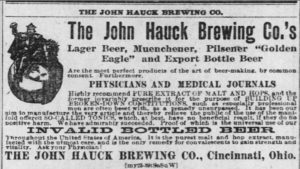"When [John Ulrich] Windisch died in 1879, [John] Hauck bought his share for $550,000 and organized a new corporation. One thousand shares of stock were issued and sold for $1000 a share. John Hauck held 940 shares; P.W.J. Hauck, 10 shares; F. Werner, 25; George Engel, 3; Andrew Dieterle, 10; Albert Carry, 10; Wilhelm Klump, 1; and Jacob Fresch Sr., 1. On September 16, 1882 the John Hauck Brewing Company was officially incorporated. John Hauck was president; P.W.J. Hauck, vice-president; F.J. Werner, secretary and treasurer; Dieterle and Carry were directors.

Also in 1882 the John Hauck Beer Bottling Company was established with capital of $15,000. It was operated by the brewery board. This move was interesting given the fact that John Hauck originally had opposed the bottling of beer. He believed that the flavor and texture of the beer would change in the bottle. However, to do business with more distant markets, he had to agree to the logic of bottling his precious brew.

The directors of the corporation agreed to expand the brewery in 1884. They set aside $52,000 for this purpose. The brewery complex covered the block bounded by Central, Dayton, York Streets and Kewitt Alley. (The old German Protestant Cemetery in this area had to be moved.) The Hauck Brewery's tall chimney was a local landmark at the time. By 1888 the brewery had three ice machines with a capacity of eighty tons. The malt house had three malt kilns and the brewery used 30 delivery wagons. Over 100 men worked to produce Hauck's beers. They included: 'John Hauck Golden Eagle Lager', 'Export Lager', 'SuperFine', and Pilsner. Also 'Invalid Beer' was brewed. Hauck claimed that it would improve the health of the weak and the dyspeptic.
The John Hauck Brewing Company owned several local saloons which sold the various Hauck beers. Other local breweries also did this to be sure that they could sell their beer. Because there were over two thousand saloons in Cincinnati in the 1880's competition was stiff. Most of them began to offer free lunches with the purchase of beer. Few could resist this temptation. Even John Hauck himself at lunch at the saloon across the street from the brewery for free.
If Hauck was careful about the way he spent his money, he was even more cautious about how his beer was handled. He instructed his drivers to carry the barrels into the saloon. They were not permitted to roll them off the wagon onto the ground and into the cellar. Hauck believed that the beer would be too foamy to use for three days.
John Hauck's son Louis, after studying brewing in Munich, joined the brewery in 1885. In 1890 he was elected to the board of directors. In 1892, P.W.J. Hauck resigned as vice-president and Louis Hauck took his place. When John Hauck resigned in 1893, Louis Hauck became president of the brewery. Then P.W.J. Hauck became vice-president; Werner, secretary-treasurer; and the directors were George WWeimar and Emily Hauck Heine, Louis' sister. John Hauck died in 1896. His stocks were divided between his widow, Catherine, his son, Louis and his daughter, Emily.

Louis Hauck reduced the kinds of beers produced to 'Imperial','Golden Eagle lager', and 'Special Dark.' He also hired J.M. Dial as sales agent for Kentucky in 1898. By this time over 300,000 barrels of beer were brewed.
When Fredrick Werner died in 1912, Edward Schulz took his place as secretary-treasurer. In 1923 Jacob Hoffman replaced him.
Louis Hauck insisted on almost perfect cleanliness in the brewery and the surrounding sidewalks. He even went to the extent of conducting surprise white glove inspections of the machinery, boilers, vats, generators, and bottling devices included.
When Prohibition became law in 1919 the Hauck Brewing Company shifted to the production of near-beer and soda pop and making and selling ice. The change proved unsatisfactory to the directors of the brewery. As time went on, more and more of the plant was leased to Red Top Brewing Company which wanted to operate on such conditions. On March 12, 1927, 46,500 gallons of near-beer was pumped into the sewer in the street. The Internal Revenue officer did not consider that beer would foam under such circumstances. Soon about 250 feet away beer foam forced open a manhole cover and beer flowed over the street.
After Prohibition, Red Top Brewing Company maintained the lease of the brewery plant and the John Hauck Brewing Company never returned to the beer business. Louis Hauck died in 1942." Cincinnati Breweries, Robert J. Wimberg (1997)
